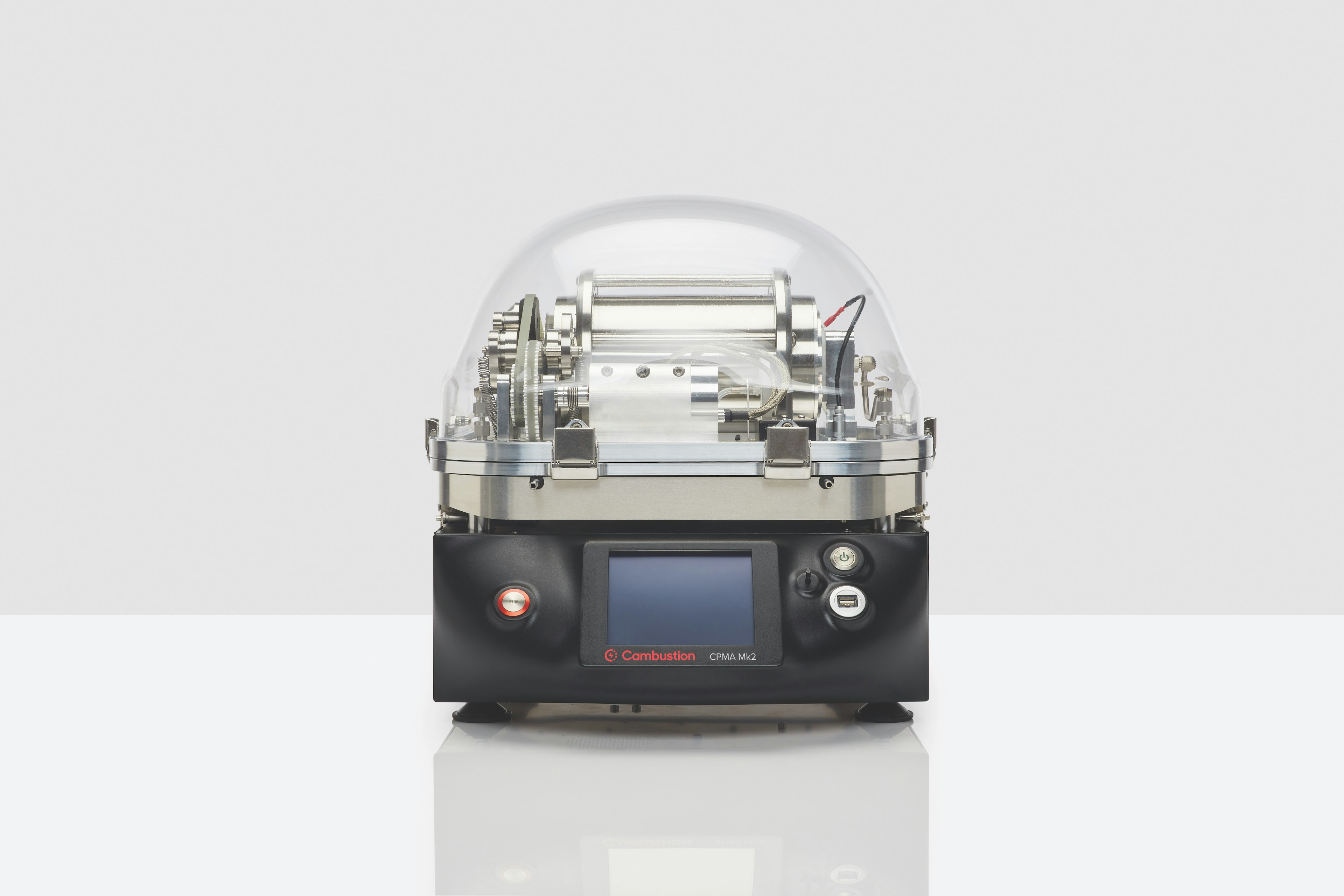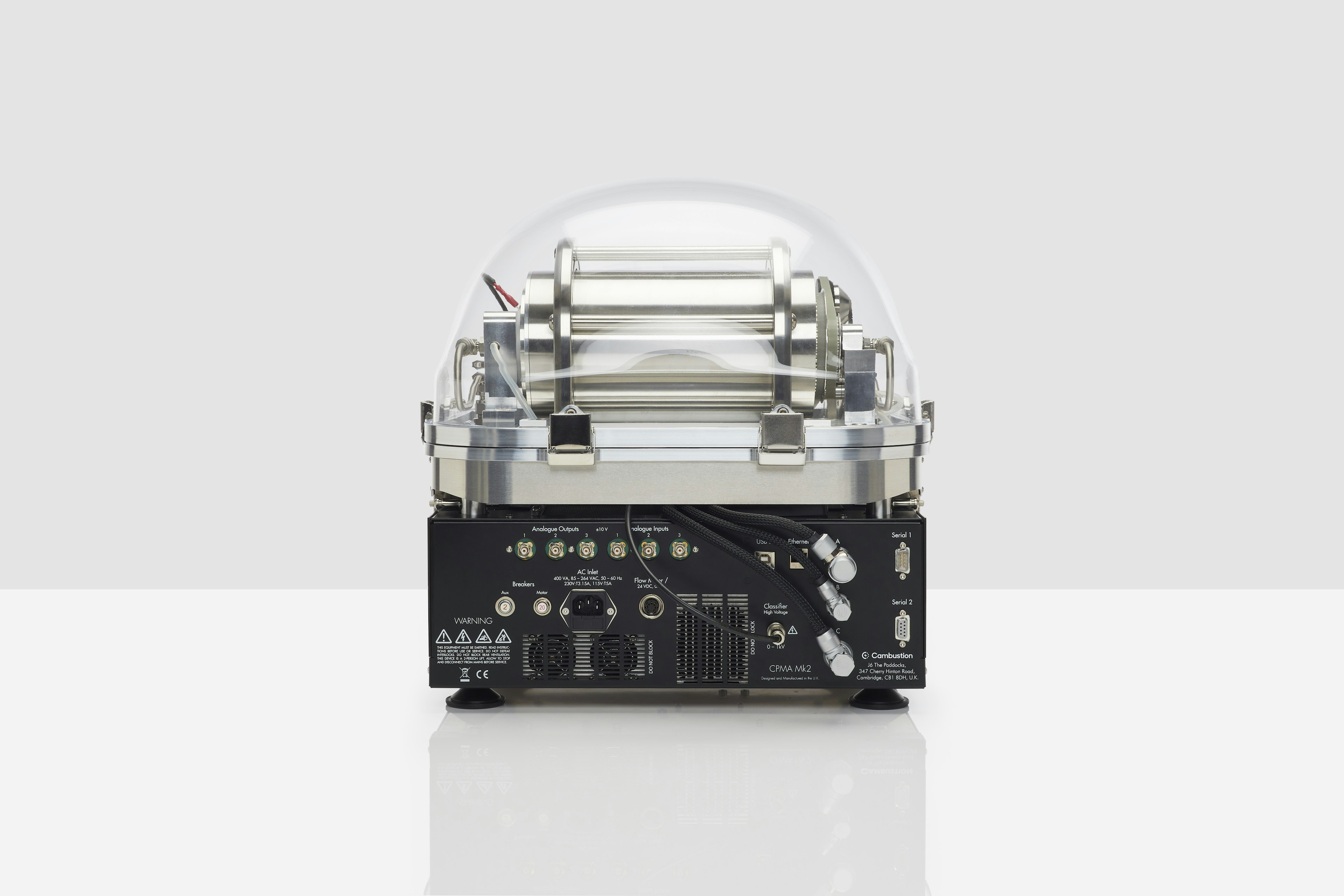CPMA | Centrifugal Particle Mass Analyser
Second generation
The CPMA was re-engineered in 2020 as the Mk2. It can now classify positive or negative particles, and has a 6 times greater mass range (or twice the size range, up to 2.3 μm). It has a larger screen, built-in USB connectivity, all stainless steel inlet and outlet paths, leak detection and features which make it even easier to clean and move around. It is a key component of the Mass and Mobility Aerosol Spectrometer (M²AS).
The Centrifugal Particle Mass Analyser
Established for over 10 years and now in its second generation, the Centrifugal Particle Mass Analyser (CPMA) allows classification of positively or negatively charged aerosol particles by mass:charge ratio. Unique features give the CPMA an unrivalled transfer function, ensuring high particle throughput even at high resolution.
The classification by mass:charge ratio makes the CPMA the ideal instrument for experiments where mass is the preferred metric, as true mass properties can be measures independently of particle morphology.
The working principle is explained in this animation.
Monodisperse aerosol selection
With a neutraliser (or charger)
The CPMA can be used as an alternative to a Differential Mobility Analyser (DMA) to select a monodisperse aerosol; as the aerosol is monodisperse by mass:charge, a much higher resolution in terms of mass is achieved than with a DMA – in particular for non-spherical particles.
Mass distribution measurements
With a neutraliser (or charger), and a detector (Condensation Particle Counter, CPC, or aerosol electrometer)
The CPMA supports direct connection to a range of detectors, including the Cambustion 5210 CPC, and integrated software allows scanning of the mass setpoint to determine the mass distribution of a charged aerosol.
Tandem classifier experiments
With a DMA or an Aerodynamic Aerosol Classifier (AAC)
To characterise non-spherical particles (through mass-mobility distributions, and effective density or shape factor determination), and study hygroscopicity and secondary coating effects.
Aerosol mass calibration standard
With a unipolar charger (such as the Cambustion UDAC) and aerosol electrometer
The CPMA forms part of the CPMA Electrometer Reference Mass Standard (CERMS), which offers a traceable standard for suspended aerosol particle mass and can be used as a calibration reference for other instruments such as aerosol mass spectrometers and black carbon detectors.
Black carbon studies
With the Single Particle Soot Photometer (SP2) by DMT
To determine the mass of coating and determine the mixing state of lab-generated or atmospheric particles using the freely available inversion algorithm.
Enhanced characterisation of non-spherical particles up to 3 μm
As part of the new Mass & Mobility Aerosol Spectrometer (M²AS)
The CPMA is a key component of Cambustion's M²AS which offers simultaneous measurement of aerosol mass, mobility, and density distributions. The measurement range of ~50 nm – 3 μm is much wider than what is possible with a DMA-based technique, and uniquely accurate characterisation of non-spherical particles is possible as no assumptions are required about the charge state.
CPMA Brochure
For more information or a list of publications relating to the CPMA, download a brochure. Please contact Cambustion for further information and prices.
Key Application Notes
| Title | Data Type | Download File | Size | Last Updated | |||||
|---|---|---|---|---|---|---|---|---|---|
| Title | Use of the Cambustion CPMA for absolute mass calibration of the Single Particle Soot Photometer (SP2) | Data Type | Application note | Download File | cpma04v02-mass-calibration-sp2.pdf | Size | 886.52 KB | Last Updated | |
| Title | Use of the Cambustion CPMA to provide a mass monodisperse aerosol | Data Type | Application note | Download File | cpma01v01-mass-monodisperse-aerosol.pdf | Size | 479.63 KB | Last Updated | |
| Title | Density and Mass Mobility Exponent Determination with the CPMA | Data Type | Application note | Download File | cpma02v01-mass-mobility-exponent.pdf | Size | 878.17 KB | Last Updated |
Support & downloads
CPMA Igor Pro toolkit for data presentation
This utility requires Igor Pro 7 for PC or Mac. It is provided free to the community with no implied warranty. Download the .zip file, unzip and open the README.txt file for details of how to use.
Data inversion algorithm for CPMA-SP2
The utility requires Igor Pro 7 for PC or Mac. It is provided free to the community with no implied warranty. Download the .zip file, unzip and open the README.txt file for details of how to use.
AF10 Aerosol Flowmeter
The CPMA is compatible with the new AF10 standalone aerosol flowmeter, offering real-time measurement of the aerosol flow (via orifice delta P) which can be used to maintain constant resolution on the CPMA and monitor performance of other connected equipment.
Find out moreCPMA Animation
The CPMA uses opposing electrical and centrifugal fields to classify particles, with the ability to vary the electrical field and rotation speed to select different particle masses.


